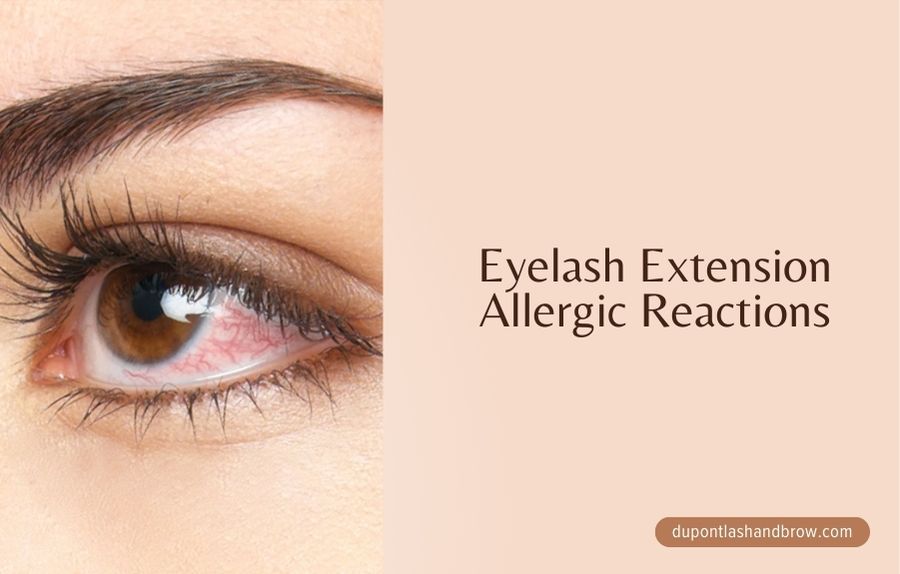Recognizing the Symptoms of an Allergic Reaction
Common Symptoms
An allergic reaction to eyelash extensions can manifest through various symptoms, which can range from mild to severe. It is essential to recognize these signs early to prevent further complications.
- Redness: The eye area may appear red and irritated.
- Swelling: Swelling of the eyelids or surrounding skin.
- Itching: Persistent itching around the eyes and eyelids.
- Burning Sensation: A burning feeling in the eyes or on the eyelids.
- Tearing: Excessive tearing or watery eyes.
Severe Reactions
In rare cases, individuals may experience more severe symptoms that require immediate medical attention.
- Severe swelling: Extreme swelling that obstructs vision.
- Difficulty breathing: Respiratory issues due to a severe allergic reaction.
Causes of Eyelash Extension Allergic Reactions
Adhesive Ingredients
The adhesive used to apply eyelash extensions is the most common cause of allergic reactions. These adhesives often contain chemicals such as formaldehyde, which can trigger allergic responses.
- Formaldehyde: A common allergen found in many adhesives.
- Cyanoacrylate: Another chemical in adhesives that can cause irritation.
Material Sensitivity
Some individuals may be allergic to the materials used for the extensions themselves, such as synthetic fibers, mink, or silk.
- Synthetic fibers: Potential allergens for some people.
- Natural materials: Mink or silk can also cause allergies.
Improper Application
Allergic reactions can also occur due to improper application techniques, such as excessive adhesive use or poor hygiene practices.
- Excessive adhesive: Increases the risk of allergic reactions.
- Poor hygiene: Can introduce irritants or allergens during application.
Preventing Eyelash Extension Allergic Reactions
Patch Testing
Performing a patch test before the full application can help identify potential allergies and prevent severe reactions.
- Patch test: Apply a small amount of adhesive to the skin to check for reactions.
- Observation period: Wait 24-48 hours to monitor for any symptoms.
Choosing the Right Products
Selecting hypoallergenic adhesives and high-quality materials can reduce the risk of allergic reactions.
- Hypoallergenic adhesives: Formulated to minimize allergens.
- Quality materials: Opt for materials less likely to cause reactions.
Professional Application
Ensure that a trained and experienced technician applies your eyelash extensions to minimize the risk of allergies.
- Experienced technicians: Knowledgeable about safe application techniques.
- Hygiene practices: Follow strict hygiene protocols to avoid contamination.
Treatment for Eyelash Extension Allergic Reactions
Immediate Steps
If you experience an allergic reaction, taking immediate action can help alleviate symptoms and prevent further complications.
- Remove extensions: Carefully remove the eyelash extensions as soon as possible.
- Clean the area: Gently clean the eye area with a mild cleanser and cool water.
Medical Treatment
For more severe reactions, seeking medical treatment is necessary to manage symptoms effectively.
- Antihistamines: Over-the-counter or prescription antihistamines can reduce itching and swelling.
- Corticosteroids: Topical or oral corticosteroids may be prescribed for severe inflammation.
- Eye drops: Anti-inflammatory or antihistamine eye drops can soothe irritation.
Benefits of Pre-Made Fan Extensions
These extensions are great for those seeking the volume look without the lengthy application process.
- Time-saving: Faster application compared to handmade volume fans.
- Consistent results: Pre-made fans provide a uniform look.
Home Remedies
For mild reactions, home remedies can provide relief and comfort.
- Cold compress: Apply a cold compress to reduce swelling and soothe irritation.
- Aloe vera: Natural aloe vera gel can help calm inflamed skin.
Preventing Future Reactions
Avoiding Known Allergens
Once you identify the cause of your allergic reaction, avoid using products that contain those allergens.
- Read labels: Check ingredient lists for known allergens.
- Consult with your technician: Discuss alternative products and materials.
Avoiding Known Allergens
Regular maintenance and proper aftercare can help prevent future allergic reactions and keep your eyelash extensions looking their best.
- Gentle cleansing: Use gentle, oil-free cleansers to clean your eyelash extensions.
- Avoid rubbing: Do not rub or pull on your extensions to minimize irritation.
Conclusion
Book an Appointment Today!


